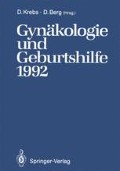Zusammenfassung
Bis in die neueste Zeit hinein wurde das Immunsystem als ein autonomes System ohne funktionelle Verbindungen mit dem zentralen Nervensystem (ZNS) angesehen. Das Fehlen lymphoiden Gewebes im ZNS einerseits und die vermutete Funktion der Blut-Hirn-Schranke als Schranke gegen das Eindringen immunkompetenter Zellen in das ZNS (12) gaben zu der Vermutung Anlaß, das zentrale Nervensystem und das Immunsystem seien zwei völlig voneinander unabhängige Systeme.
Access this chapter
Tax calculation will be finalised at checkout
Purchases are for personal use only
Preview
Unable to display preview. Download preview PDF.
Literatur
Ader, R, Cohen, N (1991): The influence of conditioning on immune responses. In: Ader R, Feiten, DL, Cohen N (eds) Psychoneuroimmunology, second edition. Academic Press, San Diego New York p 611.
Baltrusch HJF, Gehde E, Titze I, Heinze H-J (1992): Early socialization and development of cancer in later life: Biopsychosocial and Psychoneuroimmunologie aspects. Ann N Y Acad Sei 650: 355–362.
Barraclough, J, Pinder P, Cruddas M, Osmond C, Taylor I, Perry M (1992): Live events and breast cancer prognosis. BMJ 304:1078–81.
Bartrop RW, Lazarus L, Luckhurst E, Kilch LG, Penny R (1977) Depressed lymphocyte function after bereavement. Lancet I: 834–836.
Besedovsky HO, DelRey A, Sorkin E, DaPrada M, Burri R, Honegger C (1983) The immune response evokes changes in brain noradrenergic neurons. Science 221: 564–566.
Biziere K, Guillaumin JM, Degenne D, Bardos P, Renoux M, Renoux G (1985) Lateralized neocortical modulation of the T-cell lineage. In: Guillemin R, Cohn M, Melnechuk T (eds) Neural modulation of immunity. Raven Press, New York p 81.
Blalock JE (1984) The immune system as a sensory organ. J Immunol 132: 1067–1070.
Bovbjerg DH, Redd WH (1992) Anticipatory nausea and immune suppression in cancer patients reeeiving cycles of chemotherapy: conditioned immune response? In: Schmoll HJ, Tewes U, Plotnikoff NP (eds) Psychoneuroimmunology. Hogreve & Huber, Lewiston Toronto Bern Göttingen p 237.
Eggert F, Luszyk D, Westphal E, Müller-Ruchholtz W, Ferstl R (1990) Vom Gen zum Geruch zum Verhalten. TW Neurol Psychiatrie 4: 889–892.
Geschwind N (1984) Immunological associations of cerebral dominance. In: Behan P, Spreafico F (eds) Neuroimmunology. Raven Press, New York p 451.
Hickey WF, Kimura H (1988) Perivascular microglial cells of the CNS are bone marrow derived and present antigen in vivo. Science 239: 290–292.
Leibowitz S, Hughes RAC (1983)(eds) Immunology of the nervous system. Arnold, London.
Lysle DT, Luecken LJ, Maslonek KA (1992) Modulation of immune status by a conditioned aversive stimulus: evidence for the involvement of endogenous opioids. Brain Behav Immun 6: 179–188.
Madden KS, Livnat S (1990) Catecholamine action and immunologic reactivity. In: Ader R, Feiten DL, Cohen N (eds) Psychoneuroimmunology, second edition. Academic Press, San Diego New York p 283.
Maestroni GJM, Conti A (1991) Anti-stress role of the melatonin-immuno-opioid network: evidence for a physiologic mechanism involving T cell-derived, immunoreactive ß-endorphin and metenkephalin binding to thymic opioid reeeptors. Intern J Neuroscience 61: 289–298.
Mayer B, Funke I, Seed B, Riethmüller G, Weiss E (1990) Expression of the CD6+ T-lymphocyte differentiation antigen in normal human brain. J Neuroimmunol 29: 193–202.
Metal’nikov S, Chorine V (1926) The role of conditioned reflexes in immunity. Ann Pasteur Inst 40: 893–900.
Müller N (1990) Aspekte aus Neuroanatomie, Neuroendokrinologie und Neurotransmitter- Forschung bei der Interaktion von Nervensystem und Immunsystem. In: Kaschka WP, Aschauer HN (eds) Psychoimmunologie. Thieme, Stuttgart New York p 19.
Müller N, Ackenheil M, Hofschuster E, Mempel W, Eckstein R (1991) Cellular immunity in schizophrenic patients before and during neuroleptic treatment. Psychiatry Res 37: 147–160.
Müller N, Frenzel KH, Kretzschmar H, Ackenheil M (1992) T-cell and T-cell receptor antigenic struetures in human brain. Clin Neuropharm 15, Supp 1: 305B.
Müller N, Hofschuster E, Ackenheil M, Eckstein R (1992) T-cells and psychopathology in schizophrenia: relationship to the outcome of neuroleptic therapy. Acta Psychiatr Scand (in press).
Müller N, Hofschuster E, Ackenheil M, Mempel W, Eckstein R (1992) Investigation of the cellular immunity during depression and the free interval: evidence for an immune activation in affective psychosis. Progr Neuro-Psychopharmacol & Biol Psychiatry (in press).
Persky VW, Kempthorne-Rawson J, Shekelle RB (1987) Personality and risk of cancer: 20-year follow-up of the western electric study. Psychosom Med 49: 435–449.
Schleifer SJ, Keller SE, Camerins M, Thornton JC, Stein M (1983) Suppression of lymphocyte Stimulation following bereavement. JAMA 250: 374–377.
Yamaguchi M, Yamazaki K, Beauchamp GK, Bard J, Thomas L, Boyse EA (1981) Distinctive urinary odors governed by the major histocompatibility complex of the mouse. Proc Natl Sei USA 78: 5817–5820.
Author information
Authors and Affiliations
Editor information
Editors and Affiliations
Rights and permissions
Copyright information
© 1993 Springer-Verlag Berlin Heidelberg
About this paper
Cite this paper
Müller, N. (1993). Psychoimmunologie und Onkologie. In: Krebs, D., Berg, D. (eds) Gynäkologie und Geburtshilfe 1992. Springer, Berlin, Heidelberg. https://doi.org/10.1007/978-3-642-77857-5_246
Download citation
DOI: https://doi.org/10.1007/978-3-642-77857-5_246
Publisher Name: Springer, Berlin, Heidelberg
Print ISBN: 978-3-642-77858-2
Online ISBN: 978-3-642-77857-5
eBook Packages: Springer Book Archive

